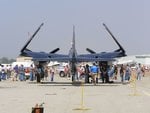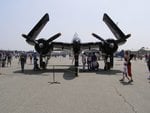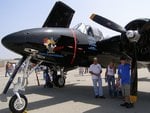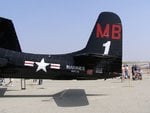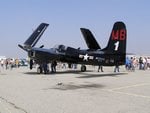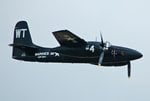Matt308
Glock Perfection
This makes for a great read...
__________________________________________
By Corky H. Meyer, Flight Test Pilot
The relatively unknown Grumman Tigercat was the first production Navy fighter to better the performance and capabilities of land-based fighters. The two Grumman twin-engine fighter prototypes that preceded it, the Navy XF5F-1 Skyrocket and the Army Air Corps XP-50, were both designed and tested before the United States entered WW II, so they provided little or no background combat experience for the Tigercat design.
On June 26, 1942, the XF6F-3 Hellcat had just emerged from the Grumman experimental hangar in Plant One, so space became available for the many twin-engine XF7F-1 (Grumman design 51) subassemblies that were coming in from the other Grumman Bethpage plants. I was not privy to the early months of the Tigercat's design and construction because of my Hellcat test-flying commitment from December '42 to July '43. But in August 1943, I was ordered by Bob Hall, assistant chief engineer for Experimental, to find a wooden box and literally sit next to the XF7F-1 prototype as it was being completed so that I could learn as much as possible about its anatomy. This was the best possible spot anywhere in the United States for a 23-year old test pilot to obtain the equivalent of an advanced aeronautical degree. I was to learn about and have a say in many of the useful design decisions that were made during the three months I spent "in" my "box" seat.
On October 23, 1943, I participated in engine runs, systems checkouts and high-speed taxi tests. On November 2, Bob Hall lifted the Tigercat off the tarmac for a few feet and landed it. The next day, for its official first flight, Bob flew it for 20 minutes. He flew four more flights and then turned it over to me as project pilot. My first flight was on November 10, 1943. At that time, I had a total of 36 hours and 10 minutes twin-engine time in training aircraft, and they had less than 30 percent of the power of the twinengine XF7F. This was very heady stuff for a J-3 Cub-trained test pilot.
The noise of two 2,000hp Pratt Whitney R-2800-10B engines just outside the thin canopy was most impressive. I never made a first flight that was as powerfully soul-stirring as the first flight I made in the XF7F-1 one day before my first anniversary at Grumman. Even my first flights in jets weren't as memorable. It was mind-boggling to keep this eight-gun fighter in a 30-degree climb until it attained its service ceiling. In comparison, the soon-to-be-famous six-gun F6F-3 Hellcat fighter I had been testing suddenly seemed like an elderly pussycat.
THE XF7F-1 GETS A NAME
Early in the XF7F-1 flight-test program, the flight-test group informally dubbed it "Tomcat." The name seemed to fit a night fighter, so Grumman proffered it to the BuAer fighter desk in Washington D.C. and was surprised when the name was denied. The Navy letter stated, "The name 'Tomcat' is unacceptable. It denotes feline promiscuity." Period; end of message. It did accept the second name "Tigercat," as not being as socially and politically unacceptable. Twenty-five years later, in a completely different cultural climate, the F-14's Tomcat name went over the hurdles without a hitch. It may have been because the three top admirals in Naval Air at the time were all named Tom: Moorer, Connelly and Walker!
MY FIRST
"PENALTY" AIRSHOW
On December 5, 1943, a group of Washington Navy brass came to Grumman's Bethpage plant to discuss the progress of the XF7F-1 program and to see the plane demonstrated. It would be my 15th flight in the Tigercat, and I looked forward to showing off this very powerful aircraft.
I made a very short, flaps-down, full-power takeoff at 75mph; the aircraft climbed at an outrageous angle compared with the production Hellcat that had taken off just before me. I picked up speed and came in for a 400mph-plus, low-level pass. As I approached the end of the runway at treetop level, I suddenly saw the Beau Sejour restaurant flagpole and its waving flag directly in front of me about 30 feet higher than my altitude! To go over it, I pulled up quickly; this required an abrupt pushover to get back to the runway in time for a low-level pass. After passing the admiral's group in the tower, I made a 5G pull-up to start a Cuban-8 loop.
When I was vertical, a call from the tower said that Flight 2 (Bud Gillies, vice president of Flight Operations) wanted to see me in his office immediately after landing. Sensing what might be in store for me, I made a slow-speed overhead pass in the carrier-approach condition and followed this with a very slow carrier-type landing and a quick trip to his office. I didn't know what I had done to warrant the summons, but it soon became apparent that Bud, who was not slow with his thoughts, was madder than a hornet. He said that I had been reckless with the experimental aircraft because, from the view in the tower, it first looked as though I would hit the flagpole, which was followed by my seemingly abrupt diving crash into the runway. After a much too long, oneway conversation, he told me I would be given a week off without pay-beginning immediately! End of conference. 1 was later told that his voice could be heard over the low office partitions from one end of Plant One to the other. Gillies also notified me that I would spend the week off writing the complete Tigercat Pilot Handbook. The possibility of being fired was much more frightening than a mere one-week's salary loss.
(continued)
__________________________________________
By Corky H. Meyer, Flight Test Pilot
The relatively unknown Grumman Tigercat was the first production Navy fighter to better the performance and capabilities of land-based fighters. The two Grumman twin-engine fighter prototypes that preceded it, the Navy XF5F-1 Skyrocket and the Army Air Corps XP-50, were both designed and tested before the United States entered WW II, so they provided little or no background combat experience for the Tigercat design.
On June 26, 1942, the XF6F-3 Hellcat had just emerged from the Grumman experimental hangar in Plant One, so space became available for the many twin-engine XF7F-1 (Grumman design 51) subassemblies that were coming in from the other Grumman Bethpage plants. I was not privy to the early months of the Tigercat's design and construction because of my Hellcat test-flying commitment from December '42 to July '43. But in August 1943, I was ordered by Bob Hall, assistant chief engineer for Experimental, to find a wooden box and literally sit next to the XF7F-1 prototype as it was being completed so that I could learn as much as possible about its anatomy. This was the best possible spot anywhere in the United States for a 23-year old test pilot to obtain the equivalent of an advanced aeronautical degree. I was to learn about and have a say in many of the useful design decisions that were made during the three months I spent "in" my "box" seat.
On October 23, 1943, I participated in engine runs, systems checkouts and high-speed taxi tests. On November 2, Bob Hall lifted the Tigercat off the tarmac for a few feet and landed it. The next day, for its official first flight, Bob flew it for 20 minutes. He flew four more flights and then turned it over to me as project pilot. My first flight was on November 10, 1943. At that time, I had a total of 36 hours and 10 minutes twin-engine time in training aircraft, and they had less than 30 percent of the power of the twinengine XF7F. This was very heady stuff for a J-3 Cub-trained test pilot.
The noise of two 2,000hp Pratt Whitney R-2800-10B engines just outside the thin canopy was most impressive. I never made a first flight that was as powerfully soul-stirring as the first flight I made in the XF7F-1 one day before my first anniversary at Grumman. Even my first flights in jets weren't as memorable. It was mind-boggling to keep this eight-gun fighter in a 30-degree climb until it attained its service ceiling. In comparison, the soon-to-be-famous six-gun F6F-3 Hellcat fighter I had been testing suddenly seemed like an elderly pussycat.
THE XF7F-1 GETS A NAME
Early in the XF7F-1 flight-test program, the flight-test group informally dubbed it "Tomcat." The name seemed to fit a night fighter, so Grumman proffered it to the BuAer fighter desk in Washington D.C. and was surprised when the name was denied. The Navy letter stated, "The name 'Tomcat' is unacceptable. It denotes feline promiscuity." Period; end of message. It did accept the second name "Tigercat," as not being as socially and politically unacceptable. Twenty-five years later, in a completely different cultural climate, the F-14's Tomcat name went over the hurdles without a hitch. It may have been because the three top admirals in Naval Air at the time were all named Tom: Moorer, Connelly and Walker!
MY FIRST
"PENALTY" AIRSHOW
On December 5, 1943, a group of Washington Navy brass came to Grumman's Bethpage plant to discuss the progress of the XF7F-1 program and to see the plane demonstrated. It would be my 15th flight in the Tigercat, and I looked forward to showing off this very powerful aircraft.
I made a very short, flaps-down, full-power takeoff at 75mph; the aircraft climbed at an outrageous angle compared with the production Hellcat that had taken off just before me. I picked up speed and came in for a 400mph-plus, low-level pass. As I approached the end of the runway at treetop level, I suddenly saw the Beau Sejour restaurant flagpole and its waving flag directly in front of me about 30 feet higher than my altitude! To go over it, I pulled up quickly; this required an abrupt pushover to get back to the runway in time for a low-level pass. After passing the admiral's group in the tower, I made a 5G pull-up to start a Cuban-8 loop.
When I was vertical, a call from the tower said that Flight 2 (Bud Gillies, vice president of Flight Operations) wanted to see me in his office immediately after landing. Sensing what might be in store for me, I made a slow-speed overhead pass in the carrier-approach condition and followed this with a very slow carrier-type landing and a quick trip to his office. I didn't know what I had done to warrant the summons, but it soon became apparent that Bud, who was not slow with his thoughts, was madder than a hornet. He said that I had been reckless with the experimental aircraft because, from the view in the tower, it first looked as though I would hit the flagpole, which was followed by my seemingly abrupt diving crash into the runway. After a much too long, oneway conversation, he told me I would be given a week off without pay-beginning immediately! End of conference. 1 was later told that his voice could be heard over the low office partitions from one end of Plant One to the other. Gillies also notified me that I would spend the week off writing the complete Tigercat Pilot Handbook. The possibility of being fired was much more frightening than a mere one-week's salary loss.
(continued)

